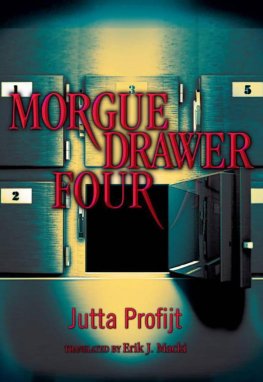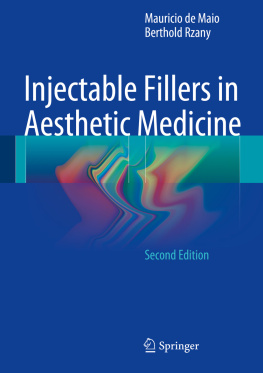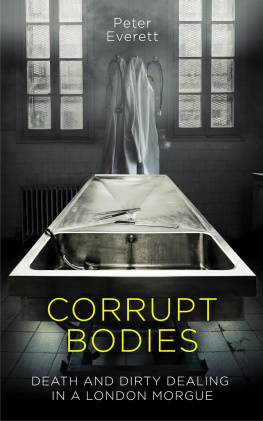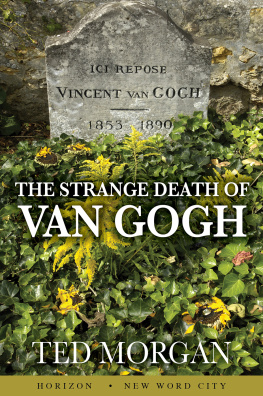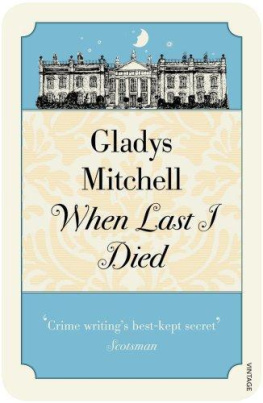Vincent Di Maio - Morgue: A Life in Death
Here you can read online Vincent Di Maio - Morgue: A Life in Death full text of the book (entire story) in english for free. Download pdf and epub, get meaning, cover and reviews about this ebook. year: 2017, publisher: Picador, genre: Non-fiction / History. Description of the work, (preface) as well as reviews are available. Best literature library LitArk.com created for fans of good reading and offers a wide selection of genres:
Romance novel
Science fiction
Adventure
Detective
Science
History
Home and family
Prose
Art
Politics
Computer
Non-fiction
Religion
Business
Children
Humor
Choose a favorite category and find really read worthwhile books. Enjoy immersion in the world of imagination, feel the emotions of the characters or learn something new for yourself, make an fascinating discovery.

- Book:Morgue: A Life in Death
- Author:
- Publisher:Picador
- Genre:
- Year:2017
- Rating:5 / 5
- Favourites:Add to favourites
- Your mark:
- 100
- 1
- 2
- 3
- 4
- 5
Morgue: A Life in Death: summary, description and annotation
We offer to read an annotation, description, summary or preface (depends on what the author of the book "Morgue: A Life in Death" wrote himself). If you haven't found the necessary information about the book — write in the comments, we will try to find it.
Morgue: A Life in Death — read online for free the complete book (whole text) full work
Below is the text of the book, divided by pages. System saving the place of the last page read, allows you to conveniently read the book "Morgue: A Life in Death" online for free, without having to search again every time where you left off. Put a bookmark, and you can go to the page where you finished reading at any time.
Font size:
Interval:
Bookmark:
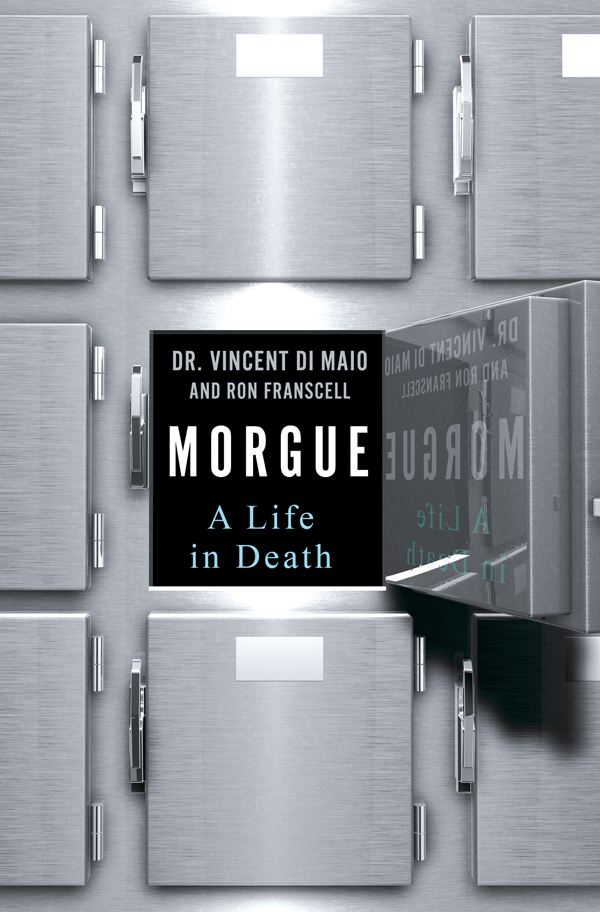

The author and publisher have provided this e-book to you for your personal use only. You may not make this e-book publicly available in any way. Copyright infringement is against the law. If you believe the copy of this e-book you are reading infringes on the authors copyright, please notify the publisher at: us.macmillanusa.com/piracy.
To Dominick J. Di Maio, MD, and Violet Di Maio
My father and mother
Death is not an individual but a social event. When, with a barely noticeable sigh, the last gasp of air is exhaled, the blood stops pulsating through arteries and veins, and neurons cease activating the brain, the life of a human organism has ended. Death is not official, however, until the community takes notice.
STEFAN TIMMERMANS
Postmortem: How Medical Examiners Explain Suspicious Deaths
Every mans life ends the same way. It is only the details of how he lived and how he died that distinguish one man from another.
ERNEST HEMINGWAY
By Dr. Jan Garavaglia
People are fascinated by forensic pathology. Yes, some are primarily interested in the forensic details, but it is the stories of how and why the dead people ended up in the morgue that intrigue most.
TV shows, movies, and novels with fictional portrayals of forensic pathologists are phenomenally popular, not because they are accurate about the art and science of forensic pathology, but because they piece together a puzzle. But every day, real-life forensic pathologists pull back the curtain to shine the light of truth on what really happened, and explore the true, hidden dramas of the human condition, too.
Many think the forensic pathologists time is spent on murder and crime, but in fact murders take up less than 20 percent of a medical examiners caseload. We care just as much about the mystery of a decomposing unidentified corpse found in a pond as we do about why an infant died suddenly in his mothers arms. Our autopsies and scene investigations might have public health or safety implications, such as identifying an emerging epidemic of drugs or disease. We might determine a woman died prematurely from a genetic abnormality, which could have profound implications for future generations of a family. We scientifically identify the burned, injured, and decomposed beyond recognition, if for no other reason than giving dignity to the dead.
Then comes murder. We determine whether a death was caused by the actions of another human, which has huge implications if you are a suspect. Even when the cause of death is obvious, the body is meticulously examined for trace evidence, subtle injuries, angles and trajectory of wounds, even natural disease anything that might shed light on what happened.
Alas, in spite of the crucial need for more forensic pathologists, it remains the medical specialty with the fewest new doctors. Thats partly the perceived negatives of the job. On a daily basis, we deal with gruesome injuries, decomposing flesh, hideous smells, horrific violence, feces and gastric contents that must be meticulously examined (or at least handled). Then we must confront grieving families and (occasionally) obnoxious lawyers.
Despite these unpleasantries, those of us in the field consider it a calling. We love the challenge of piecing together the puzzles to find the truth. We cant imagine doing anything else.
That describes Dr. Vincent Di Maio, my mentor and friend. I worked under him for ten years in San Antonio and never tired of his keen insight, his wealth of knowledge, and his seemingly limitless collection of great stories. Now in this fascinating and well-written book, readers and forensic buffs, too, are privileged to hear one of the most respected forensic pathologists in America share some of his most intriguing and provocative forensic cases of a long career.
And you will see that it isnt just about the forensics. Its about the puzzles, too.
Dr. Jan Garavaglia
Dr. Jan Garavagliabetter known as Discovery Channels Dr. Gis the chief medical examiner for Orlando, Florida, and its surrounding counties. A graduate of the St. Louis University School of Medicine, she completed her fellowship in forensic pathology at the Dade County Medical Examiners Office in Miami, and later worked for Dr. Vincent Di Maio at the Bexar County Medical Examiners Office in San Antonio, Texas.
Her hit cable TV show, Dr. G: Medical Examiner, is broadcast around the world and has made her one of the most recognizable faces of forensic medicine. She has appeared on CNN, The Oprah Winfrey Show, The Rachael Ray Show, The Doctors , and the Dr. Oz Show . She has also testified in some highly charged criminal cases, such as the Casey Anthony murder trial in 2011, and written a book, How Not to Die (2008, Crown).
I dont know whats in a human heart.
I have seen more than my share of hearts, held them in my hands. Some were young and strong; some were worn-out, shabby, choked. Many had leaked away an entire life through neat little holes caused by bullets or knives. Some had been stopped by poison or fright. A few had exploded into a thousand tiny bits or were shredded in some grotesque trauma. All of them were dead.
But I never truly knew what was inside these hearts, and never will. By the time I see them, whatever dreams, hopes, fears, ghosts or gods, shame, regrets, anger, and love they might have contained are long gone. The lifethe soulhas all seeped out.
Whats left is just evidence. Thats where I usually come in.
SANFORD, FLORIDA. SUNDAY, FEBRUARY 26, 2012.
Tracy Martin dialed his teenage sons cell number and it went straight to voice mail.
It was late, well past ten, on a dark, wet Sunday night. Tracy and his girlfriend Brandy Green had been out most of the weekend, leaving seventeen-year-old Trayvon and Brandys fourteen-year-old son Chad alone at her townhouse in the Retreat at Twin Lakes, a gated neighborhood in the relatively sedate Orlando suburb of Sanford, Florida. Tracy and Brandy had been dating for two years, and it wasnt unusual for Tracy and Trayvon to drive up from Miami, four hours each way, for an overnight or a weekend.
It wasnt just the romance. Tracy desperately wanted Trayvon to wise up, to get away from thug life in Miami, and those long trips were his chance to talk some sense into the kid.
Trayvon didnt seem to be listening. In some ways, he was a typical teenager, obsessed with girls, video games, sports, and the pounding of rap music in his earbuds. He loved Chuck E. Cheese and watching TV sitcoms. Someday, he thought hed like to fly or fix airplanes. Family was important, too, even though some of their relatives were black sheep. He often hand-fed his quadriplegic uncle, baked cookies with his young cousins, and had begun wearing a button memorializing another cousin whod died mysteriously after a drug arrest in 2008.
But Trayvon was no Boy Scout. At nearly six feet tall, he could be intimidating, and he knew it. He flirted with thug life, smoking pot and playing a badass on Facebook. In the past year, his Miami high school had suspended him three times, for tardiness, tagging, and having a bag of pot in his backpack. Tracy, a truck driver whod been divorced from Trayvons mother since 1999, began to hector the boy about his friends, his behavior, and his grades.
He dialed Trayvons number again, and again it went straight to voice mail. Brandys son Chad told them Trayvon had left around six p.m. to walk to a convenience store less than a mile away. They thought they might catch the NBA All-Star game on TV at seven thirty. Before he left, hed asked Chad if there was anything he wanted. Skittles, Chad said as he went back to his video games. Trayvon tugged on his hoodie and left. He never came back.
Font size:
Interval:
Bookmark:
Similar books «Morgue: A Life in Death»
Look at similar books to Morgue: A Life in Death. We have selected literature similar in name and meaning in the hope of providing readers with more options to find new, interesting, not yet read works.
Discussion, reviews of the book Morgue: A Life in Death and just readers' own opinions. Leave your comments, write what you think about the work, its meaning or the main characters. Specify what exactly you liked and what you didn't like, and why you think so.

